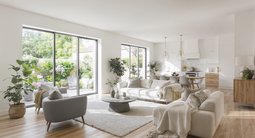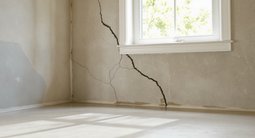TL;DR
Italy’s housing stock is old, apartment‑heavy, tightly regulated, and often inherited. Low holding costs, fragmented marketing, and renovation hurdles mean many listings look dated. New builds exist but are constrained by heritage, planning, seismic/energy codes, and land scarcity—so they’re pricey. VAT isn’t usually 22% for primary homes. If you want modern, target renovated apartments or plan a guided renovation with a local architect.
The expectation gap

Historic Italian interiors blend aged architecture with lived-in warmth and practicality.
You’re seeing a real mismatch between Italy’s global reputation for design (furniture, fashion, cars) and the average listing photos. That gap is real—but it’s driven far more by policy, demographics, and market practice than by lack of taste.
Why the stock looks old
- The stock is old and urban: Most Italians live in masonry apartments in dense historic centers; detached suburban homes are rare. - Inheritance + low carrying costs: Homes often pass down generations. Primary residences have minimal property tax; even empty places are cheap to hold. Owners don’t renovate to sell when they can wait or keep. - Dated interiors = normal: Elder owners live in them for decades. When they pass, heirs sell “as is.” Kitchens are considered furniture and are often removed. - Condo limits: In condominio buildings, changing windows/facades/AC placement needs approvals and must respect exterior rules—so superficial upgrades are common, deep ones rarer. - Seismic and energy realities: True open plans in load-bearing masonry require engineering and permits; it’s doable but not cheap. - Marketing is weak: No national MLS, limited comps, local agents, poor staging/photos. Listings often look worse than the home actually is.
Anecdote
A U.S. couple in Rome bought a drab mid-century apartment that sat for years. After a year with an architect—new systems, better light, and an open kitchen—they ended up with a bright, efficient home no listing ever showed was possible.
Why there aren’t many shiny new builds
- Heritage and planning constraints: In historic centers, demolition or contemporary exteriors are tightly controlled by the Soprintendenza and local plans. - Land scarcity where people want to live: Buildable plots near jobs/transport are limited; greenfield suburban sprawl (a la California) isn’t the norm. - Codes push costs up: New builds must meet stringent seismic and high energy classes (A/A4), with heat pumps, insulation, VMC, etc.—all good, but not cheap. - VAT myth, briefly: Buying new from a developer isn’t automatically +22% VAT. Typical rates are roughly 4% (first home, non-luxury), 10% (ordinary), and 22% (luxury categories). Buying from a private seller uses registration tax (about 2% first home, 9% second). Exact rules vary—ask a notary—but 22% isn’t the default. - Renovation incentives existed: Italy has long offered renovation/energy tax credits (now scaled back), which nudged people to upgrade old stock rather than build new.
Why some shabby homes are still expensive
- Location premiums: Lake views, coastline, Tuscan/Umbria countryside, or within A-list art cities have scarcity value regardless of interiors. - Heir dynamics and anchoring: Multiple heirs, little urgency to sell, and low carrying costs can mean ambitious ask prices and slow adjustments. - Land/use value: A ruin on a special plot can be priced for the site, not the structure. - Tourism pull: Short-term rental potential props up asking prices in certain markets.
How to find (or create) modern in Italy
- Target renovated stock: Search terms like “ristrutturato,” “ultima ristrutturazione,” “classe energetica A/B,” “impianto radiante,” “pompa di calore,” “VMC,” “cappotto,” “infissi triplo vetro.” Look for “attico,” “ultimo piano con terrazzo,” “doppi servizi.” - Where to look: Outer rings of major cities (Milan, Turin, Bologna, Florence) and well-connected new districts have the most contemporary buildings. - Expect kitchens not included: Budget to install one; this is normal. - Consider a guided renovation: Hire an architetto/geometra to scope feasibility in masonry buildings and handle permits/contractors. Rough city costs (very broad): basic refresh €400–700/m²; mid €800–1,200/m²; high-spec €1,500–2,500+ m², plus 10–15% professional/permit fees. Timelines 4–12 months. - Due diligence: Check conformità urbanistica/catastale, APE energy cert, condominio minutes (verbali), seismic risk, noise, and systems age. - Accept the style shift: Italian “modern” often means compact, energy-efficient, and durable finishes more than sprawling open plans.
Visualization Scenario
Picture a third-floor 1960s apartment with small rooms and dark wood. Remove a non-structural wall, add a steel beam where needed, refinish to pale terrazzo-look tile, full-height doors, matte-white walls, triple-glazed windows, and a compact handleless kitchen with induction and a pocket pantry. Same building, completely different feel.
Quick FAQs
- Is 22% VAT why there’s little new construction? No. VAT depends on buyer status and property type; 22% applies mainly to luxury categories. The bigger constraints are planning, heritage, land scarcity, and high code standards. - Why no open-plan lofts? Load-bearing masonry and seismic rules make big structural removals costly. It’s possible with proper engineering. - Why no landscaping like California? Detached plots are rarer; water use and urban density limit lawns. Mediterranean gardens skew hardscape/shade/containers. - Are Italians anti-design? No—Italian design thrives in products and hospitality. Housing reflects legacy stock, rules, and economics more than taste. - Any portals to start? Immobiliare.it, Idealista.it, Casa.it. But expect uneven data, limited comps, and so-so photography.
Bottom line
Italy’s homes look “old” because most are old, heavily regulated, and family-held, with weak incentives to spruce up for sale. New, design-forward homes exist but are few and costly where demand is high. If you want modern, focus on renovated apartments in newer buildings or plan a renovation with local pros—just don’t let bad listing photos be your only filter.
.svg)

.svg)














.png)